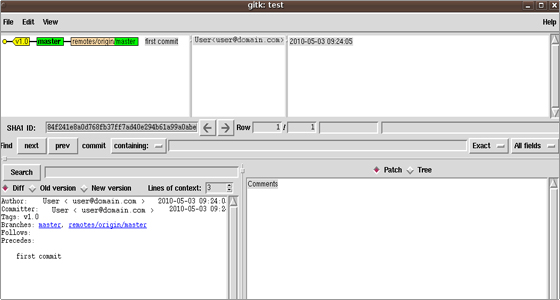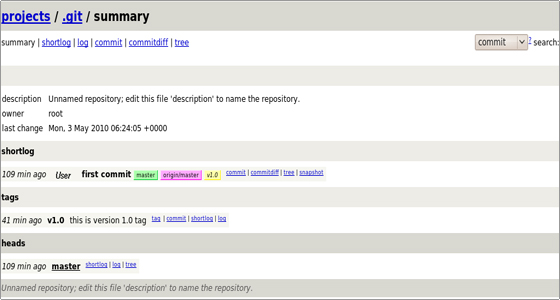Major GIT commands with examples
Here you will find a list with the major commands, their short descriptions and exemplary usage. For a detailed description of all the GIT commands please visit
http://www.kernel.org/pub/software/scm/git/docs/
Major GIT commands:
- git configSets configuration values for your user name, email, gpg key, preferred diff algorithm, file formats and more. Example: git config –global user.name “My Name” git config –global user.email “user@domain.com” cat ~/.gitconfig [user] name = My Name email = user@domain.com
- git initInitializes a git repository – creates the initial ‘.git’ directory in a new or in an existing project. Example: cd /home/user/my_new_git_folder/ git init
- git cloneMakes a Git repository copy from a remote source. Also adds the original location as a remote so you can fetch from it again and push to it if you have permissions. Example: git clone git@github.com:user/test.git
- git addAdds files changes in your working directory to your index. Example: git add .
- git rmRemoves files from your index and your working directory so they will not be tracked. Example: git rm filename
- git commitTakes all of the changes written in the index, creates a new commit object pointing to it and sets the branch to point to that new commit. Examples: git commit -m ‘committing added changes’ git commit -a -m ‘committing all changes, equals to git add and git commit’
- git statusShows you the status of files in the index versus the working directory. It will list out files that are untracked (only in your working directory), modified (tracked but not yet updated in your index), and staged (added to your index and ready for committing). Example: git status # On branch master # # Initial commit # # Untracked files: # (use “git add <file>…” to include in what will be committed) # # README nothing added to commit but untracked files present (use “git add” to track)
- git branchLists existing branches, including remote branches if ‘-a’ is provided. Creates a new branch if a branch name is provided. Example: git branch -a * master remotes/origin/master
- git checkoutChecks out a different branch – switches branches by updating the index, working tree, and HEAD to reflect the chosen branch. Example: git checkout newbranch
- git mergeMerges one or more branches into your current branch and automatically creates a new commit if there are no conflicts. Example: git merge newbranchversion
- git resetResets your index and working directory to the state of your last commit. Example: git reset –hard HEAD
- git stashTemporarily saves changes that you don’t want to commit immediately. You can apply the changes later. Example: git stash Saved working directory and index state “WIP on master: 84f241e first commit” HEAD is now at 84f241e first commit (To restore them type “git stash apply”)
- git tagTags a specific commit with a simple, human readable handle that never moves. Example: git tag -a v1.0 -m ‘this is version 1.0 tag’
- git fetchFetches all the objects from the remote repository that are not present in the local one. Example: git fetch origin
- git pullFetches the files from the remote repository and merges it with your local one. This command is equal to the git fetch and the git merge sequence. Example: git pull origin
- git pushPushes all the modified local objects to the remote repository and advances its branches. Example: git push origin master
- git remoteShows all the remote versions of your repository. Example: git remote origin
- git logShows a listing of commits on a branch including the corresponding details. Example: git log commit 84f241e8a0d768fb37ff7ad40e294b61a99a0abe Author: User <user@domain.com> Date: Mon May 3 09:24:05 2010 +0300 first commit
- git showShows information about a git object. Example: git show commit 84f241e8a0d768fb37ff7ad40e294b61a99a0abe Author: User <user@domain.com> Date: Mon May 3 09:24:05 2010 +0300 first commit diff –git a/README b/README new file mode 100644 index 0000000..e69de29
- git ls-treeShows a tree object, including the mode and the name of each item and the SHA-1 value of the blob or the tree that it points to. Example: git ls-tree master^{tree} 100644 blob e69de29bb2d1d6434b8b29ae775ad8c2e48c5391 README
- git cat-fileUsed to view the type of an object through the SHA-1 value. Example: git cat-file -t e69de29bb2d1d6434b8b29ae775ad8c2e48c5391 blob
- git grepLets you search through your trees of content for words and phrases. Example: git grep “fastwebhost.com” — *.php
- git diffGenerates patch files or statistics of differences between paths or files in your git repository, or your index or your working directory. Example: git diff
- gitkGraphical Tcl/Tk based interface to a local Git repository. Example: gitk

git instaweb
Runs a web server with an interface into your local repository and automatically directs a web browser to it. Example: git instaweb –httpd=webrick git instaweb –stop

- git archiveCreates a tar or zip file including the contents of a single tree from your repository. Example: git archive –format=zip master^ README >file.zip
- git gcGarbage collector for your repository. Optimizes your repository. Should be run occasionally. Example: git gc Counting objects: 7, done. Delta compression using up to 2 threads. Compressing objects: 100% (5/5), done. Writing objects: 100% (7/7), done. Total 7 (delta 1), reused 0 (delta 0)
- git fsckDoes an integrity check of the Git file system, identifying corrupted objects. Example: git fsck
- git pruneRemoves objects that are no longer pointed to by any object in any reachable branch. Example: git prune

 Phone: 1(877) 215.8104
Phone: 1(877) 215.8104 Login
Login